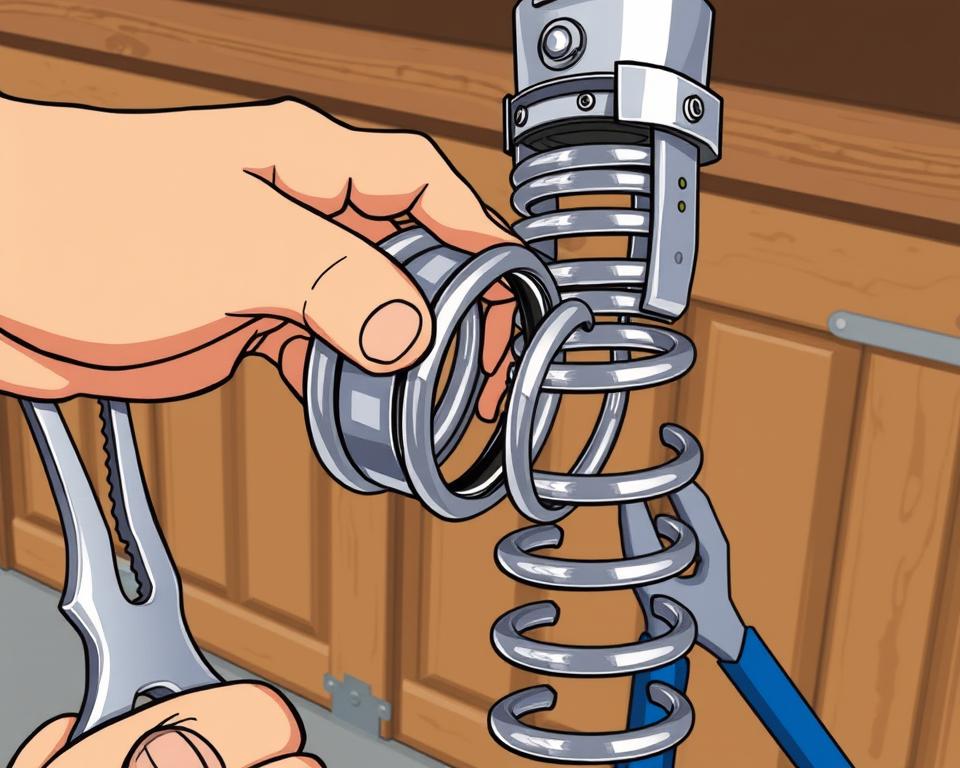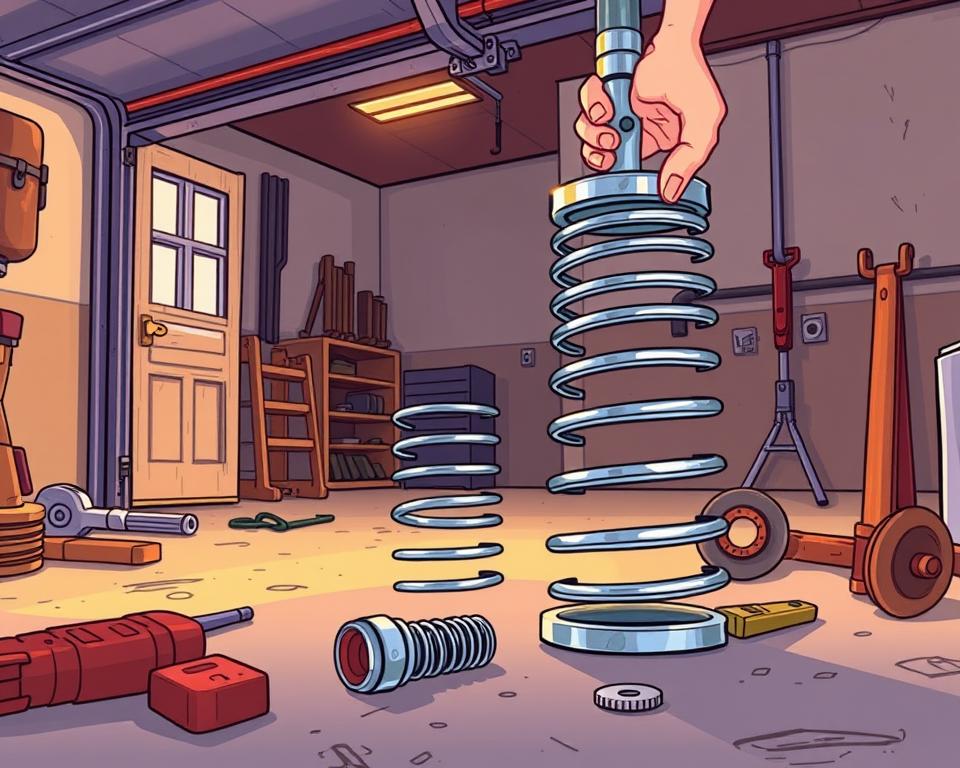As the unsung heroes of your garage door mechanism, garage door springs shoulder the full weight of doors that can tip the scales at a staggering 100kg—think of the iconic Colorbond garage door. It’s the springs doing the arduous task, not just the opener. The natural query then arises: when a spring reaches its demise in Australia, do you need to replace them both, or can you save time and cost with a single garage door spring replacement? This question taps into the broader conversation about DIY garage door maintenance and garage door spring safety, two topics that can’t be treated lightly in Australian homes.
While one eye on the budget might tempt some to embark on a solo spring-revival mission, expert advice points elsewhere. Given the high tension they bear, replacing just one spring isn’t advisable, particularly considering the intricate balance required. It’s reminiscent of tightening only one side of a see-saw—an imbalance is inevitable. Furthermore, tinkering with garage door springs sans professional insight could spell a swift voiding of your warranty, not to mention the potential personal and property hazards.
Professionals from GT Access, with over 8 years of experience in the field, remind us that each spring’s lifespan—whether torsion spring’s 10,000-20,000 cycles, or extension spring’s marginally less robust 8,000-15,000 cycles—means a break usually suggests substantial wear on both. And while the temptation to cut corners and save a few dollars is understandable, the long term costs accrued from a botched DIY job or an imbalanced door could make the professional route, averaging between $150-$350, a wise economical choice for Australian homeowners.
Understanding the Role of Garage Door Springs in Australia
Garage door springs play a critical role in the functionality and safety of garage doors across Australia. These components bear much of the load during the opening and closing cycles of the door, ensuring smooth operation and reducing strain on the garage door opener.
Principles of Garage Door Spring Mechanics
The mechanics behind garage door springs involve the conversion of mechanical energy to store and release the energy necessary to move the door. The two primary types of springs found in Australian homes include torsion springs and extension springs. Torsion springs, attached above the garage door, twist and coil on the rod to facilitate lifting, while extension springs, mounted on either side of the door, stretch and contract to provide the required force.

Types of Springs: Torsion vs Extension
Torsion springs are preferred for their durability and stability, making them suitable for heavier or double-wide doors. Proper torsion spring repair can prevent premature failures and maintain balance, reducing the risk of an unbalanced garage door. On the other hand, individuals might opt for an extension spring fix when dealing with lighter or single-car garage doors.
The Lifespan of Garage Door Springs
The longevity of garage door springs significantly depends on their usage and maintenance. On average, springs can withstand 10,000 to 20,000 cycles. Factors affecting these components include environmental conditions, the quality of the spring, and the maintenance routine employed. Given their pivotal role, engaging professionals for torsion spring repair or extension spring fix ensures efficiency and safety. Premier brands like GTACCESS and their professional service offerings underscore the importance of expert involvement in extending the lifespan of these springs.
In conclusion, understanding the types of springs, their mechanics, and their maintenance needs allows homeowners to better manage the longevity and functionality of their garage doors. Considering the complexity and risks associated with spring repair, particularly for torsion springs, professional services like those provided by GTACCESS are invaluable. They not only offer precision in installation and maintenance but also ensure safety, backed by warranties—a crucial consideration in the upkeep of any Australian home’s garage door system.
Can I replace one garage door spring
When it comes to DIY garage door maintenance in Australia, a common question that many homeowners face is whether they can replace just one garage door spring or if it’s necessary to replace both. The answer isn’t as simple as a yes or no, as several factors must be considered, from the balance and safety of the door to the longevity of the springs themselves.
Safety Considerations for DIY Spring Replacement
Garage door spring safety should be the foremost concern for anyone considering DIY repairs. Given the tension under which these springs operate and the hefty weight they bear, the replacement process is fraught with potential danger. Even for the most adept DIY enthusiast, the risks involved in manipulating high-tension springs can lead to severe injury or property damage. Professionals generally discourage attempting this task without the proper knowledge and tools.
Single Spring Replacement vs Dual Spring Replacement
Many garage door installers in Australia might opt for a single torsion spring to cut costs; however, the minimal price difference does not justify the increased risk and reduced durability. Statistics suggest that a single spring on a double-car garage door not only increases the potential for damage when it breaks but also puts additional strain on components such as cable drums and bearing plates. On the other hand, having dual springs ensures a more balanced operation, potentially doubling the life cycle of the springs and offering greater safety. With about 70% of Australian homeowners opting to replace both springs simultaneously, the trend leans towards prioritising long-term functionality and safety over initial cost savings.
Step-by-Step Guide to Assess if a Single Spring can be Replaced
Determining the necessity for single spring replacement involves a careful examination. One should inspect the springs for signs of wear, such as rust or uneven gaps between the coils. Testing the balance of the door after performing a manual lift can give insight into the tension and condition of the springs. It’s also essential to consider the age of your garage door springs; if they are nearing the end of their life expectancy, which averages around 10,000 cycles, it might be prudent to replace both to prevent future issues. Remember, a well-maintained door should operate smoothly and without any significant noise that might indicate strain on the springs. Lastly, while two-car garage doors typically require at least two springs, single-car garage doors that are smaller in size may function adequately on a single spring, as long as it’s suitably robust for the door’s weight and usage.
Can I replace one garage door spring?
Q: What is the principle mechanics behind garage door springs?
A: The principle mechanics of garage door springs involve counterbalancing the weight of the garage door to enable easy lifting and lowering. Torsion springs do this by storing energy when coiled tightly and releasing it to lift the door. Extension springs expand and contract to create a balanced movement. Both types of springs reduce the load on the opener, helping in the seamless operation of your garage door.
Q: What are the differences between torsion and extension springs?
A: Torsion springs are mounted above the garage door and use torque to balance the door, making them suited for heavier doors offering smoother operation and longer lifespan. Extension springs are located on the sides of the door or above the horizontal tracks, extending and contracting as the door operates. They are generally considered less durable compared to torsion springs and are more commonly found in older installations or lighter doors.
Q: How long do garage door springs typically last?
A: The lifespan of garage door springs can vary widely. Generally, springs are rated for a certain number of cycles, with one cycle being a single opening and closing of the door. Standard torsion springs in Australia can last anywhere from 7 to 20 years, or approximately 10,000 cycles, depending on the level of usage and maintenance. Those made with high-quality materials, such as those from New Zealand, can last up to 15 years or more with proper care. Regular maintenance, including lubrication and balance checks, significantly extends the life of these components.
Q: What safety considerations should be taken into account for DIY spring replacement?
A: Safety is of paramount importance when dealing with high-tension garage door springs. If considering a DIY approach, one must use the correct tools, follow expert guidance, understand the mechanism deeply, and strictly adhere to safety precautions. However, due to the high risk of injury or further damage to the garage door system, it’s strongly recommended that spring replacement be handled by qualified technicians who are trained to perform these tasks safely and efficiently.
Q: Should I replace just one spring, or both at the same time?
A: It’s generally recommended by professionals to replace both garage door springs at the same time. This is because springs typically have similar wear and life expectancies. Replacing only one spring can result in an unbalanced door, which may cause additional strain on the garage door system and lead to further complications and potential safety hazards. A dual spring replacement ensures even tension and operation.
Q: How can I assess if a single spring can be replaced?
A: To evaluate whether a single spring can be replaced, inspect the garage door springs for signs of visible damage, wear, or rust. A manual balance test can also help determine if the tension is consistent and appropriately balanced. However, the safest and most reliable way to assess and carry out spring replacement is by seeking professional assistance, as they have the expertise to determine the best course of action for your garage door system.
Source Links
- What Is The Cost To Replace A Garage Door Spring?
- Garage door spring repairs – GTA
- Garage Door Spring Repair & Replacement: All You Need To Know – Garage Door Repairs | Roller Door Service Gold Coast & Brisbane
- Garage Door Broken Spring Replacement – GTA
- A Comprehensive Guide on Garage Door Springs
- How to Convert from One Garage Door Spring to Two
- Can I Replace Just One Garage Door Spring?
- Replace Both Garage Door Springs? | Oregon Garage Door

